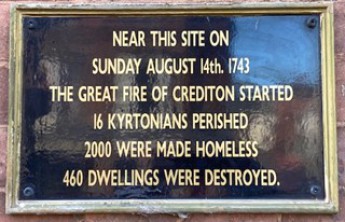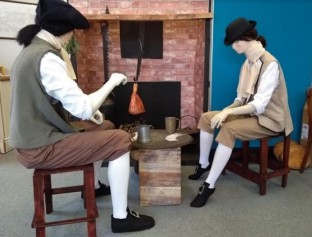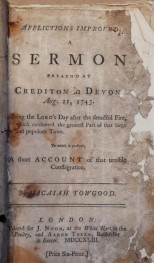
Crediton and the Great Fire of 1743
with Tony Gale on Thursday, 14 March 2024
at 7pm at The Mint Methodist Church Centre, Exeter (Wesley Room)
Our speaker Tony Gale is a Devonian with a lifelong interest in history, and, following retirement and an MA at the University of Exeter, has been working with the Crediton Area History & Museum Society and other Devon societies to further his interest in, and contribution towards, local history. His talk looked at two striking things which happened in Crediton in 1743, firstly a detailed map of the town drawn up for the Lord of the Manor and then a few months later most of the town centre being destroyed by fire.
Two hundred and eighty years ago Crediton was one of the largest towns in Devon in 1743, with only Exeter, Plymouth and Tiverton known to have larger populations. Source material for the research into the Crediton fire was taken from two contemporary reports of the fire, one from a peruke (wig) maker’s account in the Gentlemen’s Magazine and the other Rev. Micaiah Towgood’s Sermon. The map came to light in the 1970s with two sheets found in papers of the Lord of the Manor which show much information depicting the frontages of the properties with annotations added after the fire. In 2007 a third sheet came to light at auction, and was secured with financial contributions from FoDA (Friends of Devon’s Archives), CAHMS (Crediton Area History & Museum Society), SWHT (South West Heritage Trust) and the HLF (Heritage Lottery Fund).
Crediton consists of the East Town and West Town and the fire ravaged the buildings on both sides of the main street in the West Town including the Market which ran down the middle of the street. There were originally five sheets which made up the map and Sheet 5 shows encroachments made by residents building extensions to their properties in order to set up their own market stalls. The Lord of the Manor had the map drawn up as he wanted details of how and when these extensions were built, plus the measurements involved.
At first it wasn’t possible to identify the name of the mapmaker but from a rough drawing which Todd Gray had come across at the DHC (Devon Heritage Centre) it was possible to deduce that it was William Chapple who incidentally designed Dean Clarke House (RD&E Southernhay).
Much additional research into the life of Crediton was carried out by Elly Babbedge, Peter Child, John Heal and Tony Gale into buildings on the Crediton map and into people, places and businesses. Richard Parker was commissioned to produce one of his very detailed drawings to recreate what the town would have looked like.
Tony related the traditional story of how the fire started – two men drinking and playing cards whilst their dinner was cooking. Contemporary evidence points to the fire breaking out in Mr Robert Francis’s house, a maltster. It had been suggested that a house be blown up to create a firebreak, but this didn’t stop the fire and a spectator was killed by getting too near. One man – the peruke-maker, whose name we don’t know – saved his own life by crawling into a barrel, emerging once the heat of the flames had died down.
A plaque that still exists today shows those homes that had been insured by the Sun Fire Insurance Company. They apparently had their claims paid out. Fatalities numbered between 14 and 18, the number of injuries is not known, 2000 people were made homeless and it is not known how many livelihoods had been lost.
The weekend after the fire Micaiah Towgood in his sermon told his congregation that the fire was not an accident, but an act of God, and that their behaviour was to blame. On the Saturday after the fire – which was the next market day in Crediton – the marketplace was still in ruins. Some stallholders set up stalls in the East Town. Mrs Joanna Chaban, the Farmer of the Market and wife of Captain (later Major) Peter Chaban of the Dragoon Guards, went to collect and keep the market tolls.
Following the fire a relief fund was quickly established and contributions came in from far and wide. A highway robbery took place in London of the Western Mail on 8 February 1744 where sixteen Bank Post Bills payable to the Rev. John Stacey and Micaiah Towgood underwritten “for the use of the poor Sufferers by Fire at Crediton, Devon” were stolen. It transpired that the highwayman was actually a woman dressed in a wig and men’s clothes with her face covered. Anne Hawks was subsequently arrested in possession of the stolen bills at Ostend where she had travelled to and was later brought to trial holding a child in her arms in the court room. The Jury concluded that there was insufficient evidence to convict her, and she was acquitted. Tony concludes in the book that “there is no known record of anyone ever being found guilty of the crime.”
A very detailed book was published from the research carried out and contains far more information than can be conveyed in this brief write-up. The book is obtainable from the Crediton Area History & Museum Society.
[Sue Jackson]
[The photo of the plaque is courtesy of Judith Hosking; all other images are courtesy of Tony Gale]



